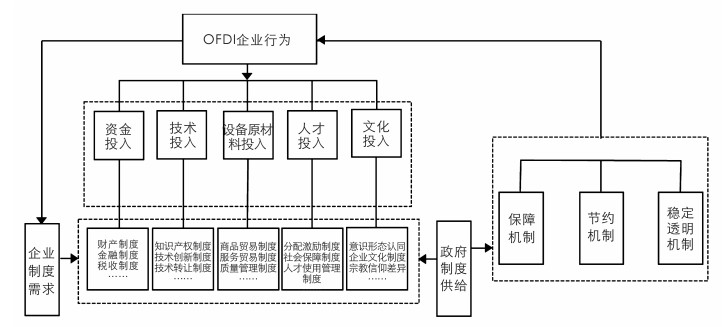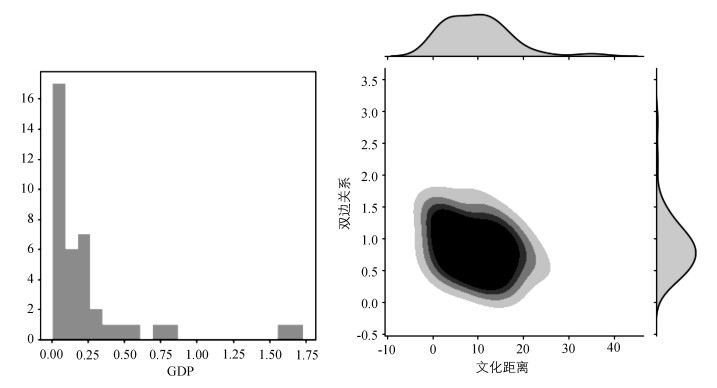全文HTML
-
自2000年“走出去”经济发展方针提出以来,中国对外直接投资(Outward Foreign Direct Investment,以下简称OFDI)一直保持高速增长。2008年全球经济危机后世界处于“大变局”之中,尤其是近年来“逆全球化”思潮、贸易保护主义盛行,各种退群、关税大棒、贸易制裁等行为削弱了WTO、APEC、NAFTA等制度规则对各国自由贸易和投资行为的约束,增加了世界经济制度环境的不确定性,严重干扰我国对外投资企业正常经营活动,抬高了企业的管制合法性门槛、规范合法性门槛和认知合法性门槛[1]。受世界宏观背景的多种影响,中国商务部网站统计,2016年中国OFDI达到高点1 961.5亿美元后,2017年、2018年、2019年已连续三年表现出逐年回落的态势,分别为1 582.9亿美元、1 430.4亿美元和1 171.2亿美元。
二战以来,西方国家通过经济全球化的先发优势和主导地位,对东道国建立了一整套包括制度在内的投资环境评价标准,却鲜少考虑发展中国家的不同历史和现实差异,在这套标准体系下,历史、文化和现实国情迥异于西方发达国家的中国以及和中国类似的其他发展中国家经济制度质量得分普遍不高,进一步导致西方国家对中国提出的“一带一路”倡议的动机、可行性乃至行动方案等多是消极评价和质疑,使中国企业对外投资面临不利的制度软环境局面。本文以中国企业“一带一路”沿线投资为例,力图揭示现有的经济制度质量评价缺陷,进一步建构更为合理的经济制度质量评价体系,探寻中国企业OFDI行为对东道国经济制度的适应性问题,理论上有助于各国之间加强不同制度的包容理解,实践上助推中国企业更好适应不同国家的制度环境,在“一带一路”投资过程中更好防范各种不确定风险。
-
经济制度曾长期与体制不分,直到康芒斯、加尔布雷思等将制度聚焦于“交易”[2],并由科思将“交易”量化为“交易费用”,通过“交易费用”界定不同的权利下不同效率的资源配置[3],新制度经济学研究完成了制度与体制的分离,明确了经济制度由交易费用衡量并与资源配置直接对应。克鲁格曼提出制度与贸易的“接口”和诺思提出“贸易由制度启动”的命题后[4],经济制度被纳入国际贸易领域。其后很长时期内,关于经济制度本身的界定是多元化的,如合约的执行力,文化差异影响的契约精神,以及通过地方保护、税率、腐败、制度的明晰程度、知识产权保护、政府干预等指标综合反映的制度内容等。
经济制度质量是评判范畴,是建立一整套经济制度的指标评价体系。早期经济制度质量好坏是通过各种经济绩效的影响影射度量,如通过东道国经济增长绩效、对外贸易绩效等评判东道国经济制度质量[5]。20世纪90年代以后,关于经济制度质量的研究表现出系统的学科分化趋势,如经济学主要强调经济的自由开放程度,政治学强调政府治理及腐败程度,公共管理科学则强调政府效率和政治风险。目前,基于规则研究制度已经达成广泛共识,综合反映制度质量的指数亦得到了普遍应用,如WGI(全球治理指数)、ICRG(国家风险指数)等,樊纲等学者编制的市场化指数应用亦十分广泛。而经济制度质量中运用最为广泛的是EFI(经济自由度指数),它是本文分析的基础。
当前在关于OFDI的研究中对中国在“一带一路”沿线的投资动因、距离因素与区位选择相关成果较多[6],或是研究我国OFDI与东道国经济增长和产业升级的关系[7],甚少涉及东道国制度对OFDI的影响。1995年EFI指标出现以后,开始出现大量以EFI作为经济制度质量指标来研究其对OFDI影响的相关成果,但结论常常大相径庭。一些学者认为,良好的经济制度质量会促进OFDI的增加[8]。一些学者认为东道国经济制度质量对中国OFDI的区位选择没有显著影响[9]。也有学者将EFI指标细分为不同维度,认为不同维度指标对OFDI影响有正有负[10]。还有学者认为,良好的经济制度会抑制OFDI的增加[11]。
关于制度质量研究的另一支文献关注于制度的稳定性,认为经济制度会随着世界经济格局以及东道国政局的变化而变化。Kydland和Prescott指出,政策制定者总是有充分的动力去变更事先的承诺,因此制度具有不稳定性[12]。稳定与否逐渐成为评价经济制度质量的重要指标之一。从研究视角上,主要有政治稳定性[13]、制度的“可信度”[14]、物价的稳定性[15]等不同切入点。结合有效性和稳定性两方面分析经济制度质量对OFDI影响成果也逐渐增多[16]。
部分中国学者基于中国实践提出了对制度质量新的认知,进一步提出制度的适应性问题。程承坪和刘素春研究了我国改革开放三十年的经济发展历史与经验,从制度衍化的角度提出,只有适合本国国情并且积极拥抱竞争进化而来的经济制度才是富有效率的[17]。何佩生从中国自身引进外资发展经济的视角出发,认为中国发展的成功除了制度冲突性低、稳健性强之外,根据经济不同发展阶段要求对经济制度进行适时的、恰当的适应性调整也是中国经济制度优势的重要构件[14]。
当前中国作为全球第二大投资输出国,迫切需要对中国企业OFDI行为针对东道国进行经济制度质量适应性分析,但相关的研究文献鲜见。中国自身具有独特的文明历史、现实国情和发展道路,“一带一路”沿线国家大多同中国一样,也具有独特的文化、宗教和国情,且自然条件相对恶劣,各种冲突、战乱不断,政权频繁更迭,不将这些独特性纳入中国和“一带一路”沿线国家经济制度质量评价,全盘采纳通行的EFI指标,主要存在两大问题:一是EFI指标是西方发达国家根据自身国情量身打造,更多考量的是发达国家企业“走出去”过程中的现实需求,依托EFI对包含中国在内的发展中国家经济制度质量进行评判时难以做到客观、科学和公正,导致中国企业难以争取到有利的经济制度环境。二是不能直接服务于中国与东道国之间的制度需求,依据这些指数,中国和东道国之间是通过向发达国家标准靠拢完成制度的适应性考察而不是彼此之间的直接制度包容衔接。通过折线距离而非直线距离完成制度的适应性考察,无疑加大了中国和东道国双方的投资效率耗损。基于此,本文借助EFI,以经济制度有效性和经济稳定性作为判断经济制度质量的基础标准;以两国间直接的制度需求为出发点,将经济制度引力和稳定性作为经济制度质量适应性标准,揭示不同标准下的经济制度质量评价差异对中国企业OFDI行为的影响,力图更为客观地评价东道国经济制度质量,帮助中国企业作出较为合理的制度环境判断和适应性调整。
本文的贡献在于:①依据中国实践经验,以对外投资企业市场经济行为的直接制度需求为基本依据,将制度的适应性纳入“一带一路”国家经济制度质量评价,与EFI所代表的经济制度质量相比,力图兼顾母国与东道国相互的制度需求;②直接服务于中国企业OFDI行为的制度需求,基于“引力法则”以中国经济制度质量为基准,考察中国与东道国之间的制度距离,力图降低现有的经济制度质量中的主观指标的影响,更客观和有效地解析东道国经济制度质量对中国企业OFDI的影响。
-
东道国经济制度是影响他国企业OFDI的重要因素。一国制度环境对企业的OFDI的影响路径研究已有一定成果。东道国经济制度质量对他国企业OFDI的影响路径如图 1所示。
整合来看,制度环境对其影响路径具体表现在:
第一,提供外商投资企业必需的制度保障机制以降低其经营风险。企业对外直接投资往往伴随一系列外部制度需求,东道国经济制度对于规范和引导企业投资行为具有重要的导向作用。哈耶克所谓的“自发秩序”是建立在国家认同并确立的一系列基本制度规则之后。如果东道国“有效政府”缺失,对外直接投资企业可能面临巨大风险,东道国则难以如愿吸引到投资,这已被许多发展中国家的实践所证明。
第二,提供外商投资企业必要的制度节约机制以降低企业的运营成本。企业对外投资过程中不得不面对投资对象国可能存在的不同于本国的文化、意识形态和宗教等方面的差异,诺思认为,重塑意识形态,建立共同的价值取向和评判标准是必要的。一方面赋予制度的合理性、合法性,可以减少企业的摩擦成本,使企业的决策过程简单明了,决策费用降低;另一方面赋予制度所谓的公平正义道德,形成意识形态的向心推力,从而减少社会成员间搭便车的机会主义行为,降低外商投资企业制度阻力,实现制度的节约机制。
第三,提供外商企业所需要的制度稳定与透明机制以保障企业的长远利益。当东道国吸引外资的政策逐渐由投资数量向投资质量转变时,大型跨国公司的投资往往更能满足投资质量方面的要求。这些跨国企业一般资本和技术实力雄厚,拥有很强的国际竞争力,其经营行为亦比较规范,十分注重企业在东道国的融入。这类企业有较强的意愿同东道国政府建立良好关系、维护企业形象、强化企业文化建设、注重包含员工培训在内的系统规范的技术转让等,积极融入东道国,保障企业生产经营的长远目标和利益。这些特征和经营思路,使他们格外注重东道国的制度稳定性与透明性,而对东道国时间维度较短的优惠政策则缺乏足够兴趣。制度的稳定性和透明性将大大增强OFDI的投资预期。
总之,对外直接投资作为一种正式的制度安排,它依存于一定的经济制度,而经济制度质量通过对OFDI的风险、成本、收益等最终影响企业的投资决策行为。几乎所有的对外直接投资企业都会细致考察和评估东道国的投资环境。
-
所谓制度质量是对制度做出的某种评价,属于规范研究范畴,通过构建指标体系最终要建立一个好或坏的价值判断尺度。由于经济制度质量涵盖范围较广,影响因素较多,截至目前并没有统一的标准。Barro认为公平竞争的宏观经济环境代表高质量[18],Rodrik认为生产的产品高品质代表高质量[19]。以风险水平来衡量经济制度水平也较为常见[20]。当前“经济自由度指数”(EFI)则是以自由开放的市场衡量制度基础,是全球较为权威的经济制度质量指标,在经济学、金融学领域运用较为广泛。EFI由《华尔街日报》和美国传统基金会联合发布,涵盖全球155个国家和地区,该指数包含10大指标,各指标的取值范围均为[0, 100],数值越高表示经济制度质量越好。本文接受经济制度质量以市场导向为基础的才是好制度[21]的判定,将EFI结合制度的稳定性共同构成经济制度质量分析基础。依此出发,在EFI十大指标中,剔除了与政府直接相关的政府诚信和政府支出指标,保留了投资自由、金融自由、产权保护、租税负担、贸易自由、经商自由、劳动自由指标等与市场直接相关的指标。货币自由指数的衡量标准是东道国的物价稳定水平,本文使用通货膨胀率(INF)作为经济制度稳定性的衡量[15]。
自1995年发布后,大量以EFI作为经济制度质量指标的研究中,良好的经济制度质量对OFDI的影响如何未有统一结论。结论迥异源自我们采用经济自由度指数(EFI)时,默认了指数的价值判断标准,而指数中包含的不合理部分也被接纳。采用这些指标时研究侧重点不同,选取指标不同,主观得分影响不同,结论自然不同。而中国企业对“一带一路”沿线国家的OFDI的逐年增加,被部分学者解读为中国企业对“一带一路”沿线国家的投资具有高经济制度风险偏好、青睐经济制度质量和法律制度质量较低的国家时,这个结论无疑将中国和东道国同时置于不利的制度环境中。汪丁丁在制度分析的三个方法论特征中提出[22]:一要敏感地对待制度差异;二要将制度的评判建立在不同国家的历史之上;三要考量制度的主观认知的区别。而EFI指标对上述三个特征常常视而不见。一方面,“一带一路”沿线各国种族、宗教情况复杂,政治制度、风土民情、文化传统等差异巨大,加上经过多个地缘政治破碎区域,不同国家之间存在经济制度的现实异质性;另一方面,同一国家不同发展时期也存在经济制度需求的差异性。以EFI中包含的贸易自由指标为例,美国传统基金会对其打分的逻辑是国际国内开放水平、自由贸易水平越高,政府对贸易管制越少则得分越高。对发达国家而言,市场机制完善、工业基础雄厚,这种自由贸易赋分有利于其国外市场的开拓。但对发展中国家而言,本国发展基础薄弱,某些情况下,现有标准下较低的贸易自由度得分可能更有利于其经济增长。有学者持有类似观点[23],认为对经济制度质量的评价应与该国的国情与经济发展水平相结合。综上所述,发展中国家适宜的经济制度质量与EFI的制度赋分并非是单纯的正向关系。基于此,本文提出第一个假设:
假设1:西方国家对经济制度质量评判标准在发展中国家中不具有普适性,这种标准的偏离会使经济制度质量得分与对外直接投资的关系发生转变。
为增进制度的适应性分析,需要寻求EFI的替代指标。陈岩和翟瑞瑞等遂用“经济制度距离”这一变量来处理母国与东道国之间的制度适应性[24],认为企业OFDI存在一定程度的制度路径依赖,更习惯于寻求经济制度质量相近的国家进行投资。从企业角度来说,盈利是对外直接投资的主要动力。东道国与母国相近的经济、政治制度有利于降低企业的适应成本,同时也有利于降低外部的不确定因素。借助于EFI指标的研究,现有的经济制度距离都是以西方发达国家作为圆心,而中国早已经成为世界第二大对外直接投资输出国。本文认为对经济制度质量的研究需要基于国内企业的OFDI活动,应该考量中国企业的制度需求,因此,从中国企业的角度去评判东道国的经济制度质量时,应该以中国为基点进行评价。本文以中国为制度“圆心”,借助经济制度距离建立一个相对评价标准,在此标准中,对经济制度质量的评价直接来自中国和东道国之间的分析,弱化了EFI中第三方的主观价值标准指标干扰项。依据“引力法则”,东道国经济制度质量越接近中国,则制度引力越强,适应性阻力越小。该标准下,两国之间的制度引力计算方法如下:
其中FCTit表示i国t年EFI评价标准下的得分值,FCTct表示对应年份中国的得分值。为扭转差值与评分的反向关系使模型解释更为直观,用100减去两者之差的绝对值,得到RFCTit。结合经济制度稳定性评判标准,构建了后文模型(2)中的制度分析基础。基于此,本文提出第二个假设:
假设2:基于引力的经济制度质量更有利于中国企业的OFDI行为对东道国的制度判断。
一. 经济制度质量对企业OFDI影响路径分析
二. 理论分析与研究假设
-
依据中国对“一带一路”沿线国家投资情况进行综合排序后,因各种原因存在一些国家投资数据为零或数据不连贯导致的样本选择偏差,依据样本数据的代表性和可用性,最终选取2006-2018年中国对39个“一带一路”沿线国家直接投资的面板数据作为样本,共有429个样本数据(见表 1)。
从经济体量上看,上述39个样本基本涵盖了从大到小不同GDP体量特征国家;从双边关系和文化距离上看,选定样本中与我国关系极为亲密(疏远)和文化差距极大(极小)的国家偏少,整体处于适中偏小,覆盖层次较为全面(见图 2);在宗教和地理位置上,样本覆盖了基督教、犹太教、伊斯兰教、印度教、佛教等世界主流宗教,并且“一带一路”沿线各大区域均有国家选入样本。因此,选定样本从数据获取的连续性、经济体量、与我国关系、文化距离以及宗教和地理上来看,均具有代表性,可以作为本文分析的基础。
-
对外直接投资(OFDI)。选取的因变量为中国“一带一路”沿线对外直接投资存量OFDI。数据来源于商务部网站公布的《2006-2017年中国对外直接投资统计公报》。
-
经济制度质量(INS)。在模型(1)中,经济制度质量(INS)包括经济制度的有效性(FCT)和经济制度的平稳性(INF)二个维度。根据本文对经济制度质量的界定,结合指标的权威性考量,主要指标来自经济自由度数据,其中有效性是通过对投资自由、金融自由、产权保护、租税负担、贸易自由、经商自由、劳动自由指标7个指标取其算数平均值得到评分(FCT)。市场稳定性是以东道国通货膨胀率(INF)来衡量。在模型(2)中,经济制度质量(RINS)主要是由经济制度的引力和经济制度的平稳性来考量,其中经济制度引力来自公式(1)的计算得分,平稳性同上。
-
(1) 东道国的资源丰富度。不同国家可能面临不同的资源比较优势,对外直接投资主要集中于自然资源的获取[6]、市场资源获取和技术战略资产的获取[25],因此东道国对应资源的丰富度选取三个不同的指标,其中:东道国国内生产总值(GDP),以此表示东道国的市场规模,数据来源于世界银行;东道国自然资源(ORE),本文选取东道国矿石、燃料与金属出口占总出口的比例(ORE)来表示东道国的自然资源禀赋,数据来源于世界银行;东道国技术资源(TEC),本文选取东道国的高科技出口额来表示东道国的技术资源禀赋,数据来源于世界银行。
(2) 中国与东道国的文化距离(CD)。两国间宗教、文化差异会造成消费者偏见的产生,阻碍投资国与东道国市场间的信息交流,增加投资企业交易成本和资源获取难度,对母国OFDI具有不利影响[26]。由于宗教问题的敏感性,本研究舍去其影响,保留文化作为非正式制度影响因子纳入。本文借鉴Kogut和Singh提出的KSI指数对文化距离进行测算[27],数据来源于Hofstede网站。计算方法如下:
$ C{D_j} = \sum\limits_{i = 1}^6 {\left\{ {\frac{{{{\left( {{I_{ij}} - {I_{ic}}} \right)}^2}}}{{{V_i}}}} \right\}} /6$ 。其中CDj代表中国与第j个国家之间的文化距离;Iij代表第j个国家在第i个文化维度的取值;Iic代表中国在第i个文化维度的取值;Vt代表第i个文化维度的方差,i的取值范围为1到6。(3) 东道国与中国的双边关系。国与国之间的双边关系表面上是政治关系,但是实际上对OFDI也存在深刻的影响[28]。本文借鉴韩民春和江聪聪研究成果,将影响对外投资的双边关系(BIL)用三个量化概念来加以处理[7]:
其中,重要文件和协议指标(DCM)为该国与中国签订的重要文件或协议数量,除以样本中所有国家所有年份与中国签订的重要文件或协议数量最大值之商;伙伴关系指标(FRI)为该国当年与中国伙伴关系得分,除以样本中所有国家所有年份与中国伙伴关系得分最大值之商;友好城市指标(CIT)为该国当年与中国友好城市数,除以样本中所有国家所有年份与中国相对友好城市系数最大值之商。相关数据均来源于中国外交部网站。
-
本文采用单边投资引力模型来对假设进行检验。引力模型起源于牛顿提出的万有引力公式,最早用于研究两国间贸易额与各自经济规模和距离之间的关系,后被证明能够有效地解释国际间的直接投资活动。引力模型认为一个国家对另一个国家的经济行为,取决于相应经济行为所关注资源的“质量”与两国之间的距离。“质量”越大、距离越近则引力越大,经济行为越活跃;“质量”越小、距离越远则引力越小,经济行为越疲软。单边引力模型基本设定如下:
eait表示t年对i国的相应经济行为的活跃程度,∏j=0n(Massijt)表示t年i国各项对应经济行为所关注资源的丰富程度,Disit表示i国t年与我国的距离。
$\mathrm{\epsilon} $ 表示相应误差。为方便估计,将非线性关系转变为线性关系:在引力模型的基础上结合本文要验证的两个假设设立两个模型:
一. 样本选取
二. 变量选取
1. 因变量
2. 自变量
3. 控制变量
三. 模型设定
-
本文使用面板数据进行假设验证,使用统计软件为stata15.0。首先检查数据相关性情况,除FCT和RFCT的相关系数较高外,其余变量之间的两两相关性不高。由于FCT与RFCT不会出现于同一个模型中,因此高的线性相关性不影响模型回归,通过检验。
为避免因数据不平稳和自变量之间的多重共线性对回归结果的影响,本文对数据分别进行了单位根(ADF)检验和方差膨胀因子(VIF)检验。ADF检验结果表明,各变量P值均为0,均在小于5%的显著性水平上拒绝“存在单位根”的原假设,变量平稳。VIF检验结果均显著小于10,表明自变量间不存在严重多重共线性,验证了相关系数矩阵的结论。并且将RFCT换成FCT,结论不发生明显变化。综合多个检验结果,样本数据可用于回归分析。
对于面板数据的通常处理方法分为混合效应、固定效应和随机效应三种。首先利用Hausman检验对固定效应模型和随机效应模型进行甄别,结果显示拒绝原假设,则应选用固定效应模型;其次,利用LM检验对混合效应和固定效应进行选择,结果仍表明固定效应优于混合效应。加之考虑到固定效应模型能够一定程度上缓解遗漏变量产生的内生性问题,本文选取固定效应模型进行回归估计。
-
模型(4)和模型(5)的回归结果见表 3。
在稳健性检验上,一是考虑到东道国市场规模、自然资源出口情况、技术禀赋出口情况及双边关系,与我国对其直接投资有双向因果关系,可能造成内生性问题导致估计结果有偏。本文参考蒋冠宏的方法,将涉及变量滞后1期重新进行检验,以观察稳健性[29]。从检验结果来看,主要结果的显著性及影响方向基本不变,说明本文的结论较为稳健。二是“一带一路”沿线国家既有广大的发展中国家,也包括一些发达国家。各国经济发展水平、资源丰富程度等影响对外直接投资的变量差距较大。本文参将涉及变量进行1%和99%的缩尾处理,在此基础上对模型再次进行回归[30]。回归结果基本一致。通过上述稳健性检验,可以认为本文的研究结论具有较高的科学性和可信性。
模型(4)考察了以EFI为依据的东道国经济制度质量对中国OFDI的影响。①经济制度有效性系数为负,说明东道国FCT越差,我国对其直接投资越多,即从经济制度有效性考量,我国倾向于投资经济制度质量更差的国家。②衡量经济制度稳定性的指标系数为正,表明一国通货膨胀率越高,其获得的我国企业直接投资越多。因为所考量的39个国家中,没有年均通胀率超过10%的国家,而通缩的国家有五个,大多数国家都处于0%~10%的温和通胀水平。在这种样本特性下,通胀对经济增长是一种有利的因素。③考虑一国资源丰富度对其获得OFDI的影响,模型显示,对于“一带一路”沿线国家资源越是丰富其获得我国的直接投资额越高。其中自然资源丰富度对其OFDI影响程度最高,其次是市场资源,技术资源相对重要性较低。表明中国总体上看对“一带一路”沿线国家自然资源的投资动机更强。④东道国与母国文化距离的关系为负,双边关系为正,说明我国更愿意投资文化距离小、双边关系好的国家。
模型(5)立足于中国企业OFDI的直接制度需求,考察了基于引力下的东道国经济制度质量对我国OFDI的影响。①在衡量经济制度质量的两个指标中,经济制度引力得分系数为正,说明制度引力越大则我国更愿意对其进行投资。②经济制度的稳定性得分为正,同模型(4)的影响方向一致。③在两国之间直接的经济制度质量引力模型下,东道国经济制度质量对OFDI影响从两个维度都呈正向关系,这验证了本文的假设2。模型(5)中,资源丰富度、文化距离和双边关系对OFDI的影响同模型(4)的结论是一致的。
比较模型(4)与模型(5),我们发现:①不同标准下,东道国经济制度质量对OFDI的影响评价不同。仅仅从经济自由度指标(EFI)上看,我国更愿意投资经济制度质量更差的国家。通过以我国为圆心,构建以经济制度质量距离为评判标准的新体系后,我国对“一带一路”沿线国家更愿意投资经济制度距离相近的国家,认为制度相近,彼此的引力更强,企业更加适应其制度环境。②根据制度引力评价标准,减轻了基于EFI的统一标准的影响,强化了两国之间的国情差异和发展阶段差异所导致的制度距离因素,诸如中国企业投资经济制度质量差的国家的结论自然消失。在国际秩序重构的“大变局”背景下,有利于降低国际上对中国企业的主观认知风险。③中国与“一带一路”沿线国家基于各自的独特历史与现实国情,采用引力模型评价标准研究中国企业对外投资时,不仅有利于自身,也有利于对东道国经济制度质量的合理判断,对投资国和东道国的直接制度距离分析对双方都是受益的。模型(4)与模型(5)的差别表明了西方国家对发展中国家经济制度质量的评价标准存在不适应缺陷,验证了假设1。同时,更为现实的考量是,中国企业在“走出去”过程中,需要与东道国相向而行,尽可能适应不同国情和发展阶段的东道国经济制度,不存在放之四海而皆准所谓的普世价值体系。
一. 数据检验与计量方法选择
二. 实证结果分析
-
1. 本文将各国之间不同国情、不同发展阶段的差异纳入经济制度质量的分析框架,以中国与东道国之间直接的制度距离衡量,将经济制度引力作为经济制度质量的适应性考查,弱化了EFI指数中绝对标准对经济制度质量的影响,让经济制度质量评价体系更加客观、公正和科学。研究结果显示:适应性制度分析不仅有利于中国经济制度质量得分,还提升了东道国的经济制度质量得分;将经济制度平稳性纳入经济制度质量体系,则是用以应对当前世界可能面临的巨大的经济波动风险。
2. 本文分别对EFI和经济制度引力作为经济制度质量的衡量标准进行比较分析,比较结果显示:将EFI作为经济制度质量的衡量基准时,中国在“一带一路”沿线国家的投资具有高风险偏好,主要投资经济制度质量差的国家;从经济制度引力视角得出的结论则是中国选择经济制度距离相近的国家进行投资而非经济制度质量差的国家。从制度质量评价的角度揭示不同学者得出“制度风险偏好”不同结论的原因。但基于中国和“一带一路”沿线国家经济制度引力得出的结论具有更客观的解释能力,更适合中国企业对东道国作出经济制度质量适应性判断。
3. 总体而言,中国对“一带一路”沿线国家自然资源的投资动机最强,其次是市场资源,技术资源相对重要性较低。同时,中国对文化距离小、双边关系好的国家投资意愿更强。今后围绕着经济制度相近(即引力更大)、双边关系较好、自然资源和市场资源较为丰富的“一带一路”沿线国家进行投资,可能对中国企业而言是更为有利的现实选择。
-
1.在政府层面上需要着力提升不同文明的包容能力和国际规则制定的影响力以扩大制度的适应范围。工业革命以来西方主导的全球化目前到了变革时刻,新的全球治理时代正在到来。“大变局”是一个重大的历史节点,未来的国际格局正面临着一次巨大的思想、文化和现代文明理念的革新,其影响不可限量。要从中国历史文化中的和谐思维与包容理念中吸取营养,在尊重各国国情、客观现实差异基础上推动“人类命运共同体”建设。也需要尽快提升国际规则制定的影响能力。既要进一步扩大开放,维护现有的国际贸易体系核心机制(即对规则的遵守和对纠纷的公平解决机制),也要采取有效的策略,利用成员身份在诸多国际组织里以符合发展中国家偏好和标准的方式推动各项变革。中国的“一带一路”倡议提供了国家能力建设的新舞台,它既是东道国适应中国的过程,那些响应倡议的国家必然获得切实的经济利益;也是中国适应东道国的过程,中国OFDI企业跨国投资亦要遵守诸多通行国际规则:透明的运作、公开的采购、环保的施工等并考虑东道国可持续性的发展。如果“一带一路”倡议成功落实,将极大拓展中国制度的适应范围。
2.企业作为国际经济交往核心,要用良好的企业形象塑造提升东道国对中国制度的认同度。企业“走出去”投资,在与东道国政府、民众和媒体的互动过程中,成为同东道国直接打交道的载体,对经济制度优劣的定位往往通过OFDI企业形象得以具象化,某种程度上承载着投资国制度形象大使的角色。正因如此,西方跨国企业在东道国投资活动中十分注重企业文化建设,通过对东道国主流媒体资金投入或直接经营自己的媒体,在当地电视、报纸、电台刊登广告来宣传自己,主导各种政治经济议题,维护自己良好的声誉并营造有利于自己的经济制度环境。中国企业的做法则远远不够,一方面某些企业只求短期的利益回报,缺乏社会责任感,在“一带一路”项目中未采纳高标准,不注重对东道国生态环境的保护。另一方面中国企业大都不愿意投入东道国媒体资源,认为投资较大,直接回报少,导致中国企业发不出自己的声音。诸多沿线国家对中国的报道主要来自西方媒体,而西方媒体新闻价值观固态化,对中国选择性报道负面甚至是虚假的消息,很难听到客观公正的评价,各种误解、偏见由此产生。中国企业需要树立社会责任意识,积极扮演好制度载体的角色。一要目标长远,切实将投资项目与东道国民众的利益捆绑在一起,以“互利共赢”思维来进行投资;二是在适当的情况下,中国企业应该多开展与当地媒体的合作与互动,要把更多的精力、资源和资金投入到能够公正、客观报道中国的媒体上,扩大自己在当地的影响力。诸多发展中国家面临自身独特的文化、历史和现实国情,其新闻媒体观念通过我们的努力可以适当改变。
3.我国智库、学者、媒体“叙事”变革正当时,迫切需要采用通行的国际学术语言维护核心价值,扩大制度的影响力。一要弥补学术威权赤字。当前,西方智库、学者的国际影响力远远强于中国智库、学者的影响力。中国知识界要有主动塑造国际价值评判标准体系的雄心与原生动力,构建适合中国企业OFDI的经济制度质量评判体系,包括理论体系、指标体系和方法体系,通过高水平制度标准研究来合理化、合法化争夺“话语权”。二要弥补媒体“话语权”赤字。由于被殖民历史,一带一路沿线诸多发展中国家形成了英语、法语精英上流社会,对中国的经济制度缺乏认同,加上消息源以欧美国家为主,议题又由欧美国家的掌控,中国媒体国际影响力十分有限。和西方媒体比起来,中国媒体需要升级换挡,由主要面向国内到注重国内外双修,拓展自己的国际视野,提升从东西方博弈、地缘政治的角度来设置议题的能力,需要用国际通行的语式讲清楚中国制度的核心价值观。
4.从“一带一路”沿线国家的投资实践出发,需要针对不同国情和现实基础,循序渐进地在全球范围内建立不同区域内的优化指标体系与制度评判标准,指导中国企业在全球的投资实践。本研究通过经济制度质量在“一带一路”沿线国家中适应性分析表明,不同区域经济体量、双边关系和文化距离等特征不同,结论亦不同。难以保证采用单一不变指标的经济制度质量评价体系判断在不同区域的适用性。因此,要从“一带一路”沿线国家的经济制度质量适应性研究出发,在不同区域根据国家的不同特质建立适应中国企业的经济制度质量评价体系指导企业跨国投资。




 下载:
下载:
